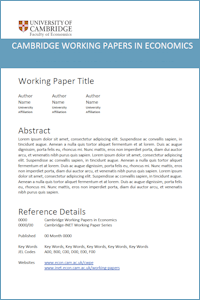
Chyong, C K., Pollitt, M., Reiner, D M., Li, C.
Modelling Flexibility Requirements in European 2050 Deep Decarbonisation Scenarios: The role of conventional flexibility and sector coupling options
CWPE2309
Abstract: Russia’s invasion of Ukraine has reaffirmed the importance of scaling up renewable energy to decarbonise Europe’s economy while rapidly reducing its exposure to foreign fossil fuel suppliers. The question of sources of flexibility to support fully decarbonised European energy system is, therefore, becoming even more important in light of a renewable-dominated energy system. We developed and used a Pan-European energy system model to systematically assess and quantify sources of flexibility in order to meet deep decarbonization targets. We find that the electricity supply sector and electricity-based end-use technologies are crucial in achieving deep decarbonization, and that other low-carbon energy sources like biomethane, hydrogen, synthetic e-fuels, and bioenergy with carbon capture and storage will also play a role. To support a fully decarbonized European energy system by 2050, both temporal and spatial flexibility will be needed. Spatial flexibility, achieved through investments in national electricity networks and cross-border interconnections, is crucial to support the aggressive roll-out of variable renewable energy sources. Cross-border trade in electricity is expected to increase, and in deep decarbonization scenarios, the electricity transmission capacity will be larger than that of natural gas. Hydrogen storage and green hydrogen production will play a key role in providing traditional inter-seasonal flexibility, and intraday flexibility will be provided by a combination of electrical energy storage, hydrogen-based storage solutions (e.g., liquid H2 and pressurised storage), and hybrid heat pumps. The role of hydrogen networks and storage will become more important as we move towards the highest decarbonization scenario, but the need for natural gas networks and storage will decrease substantially.
Keywords: Energy system modelling, spatial flexibility, temporal flexibility, networks, intraday storage, long-duration storage, power-to-x, Net Zero, deep decarbonization pathways
JEL Codes: C6 O13 Q4 Q47
Author links: Michael Pollitt
PDF: https://www.econ.cam.ac.uk/research-files/repec/cam/pdf/cwpe2309.pdf 
EPRG Paper Link: 2302
